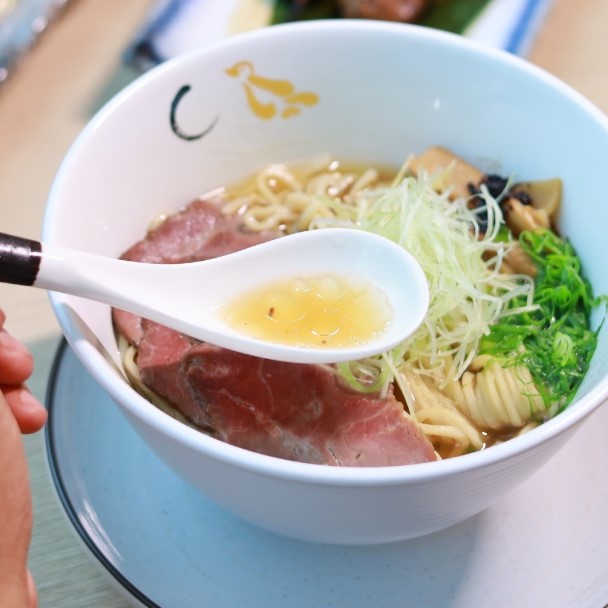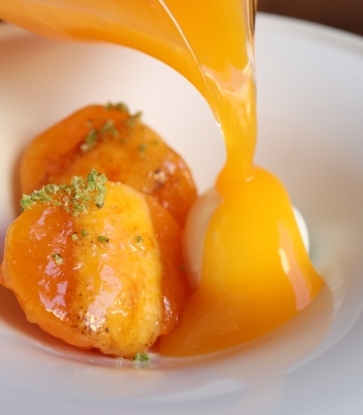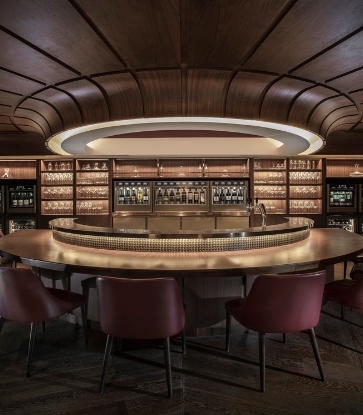Mouth-watering food, delightful atmosphere, and the warmth around the table from friends, family, and loved ones, of course, all contribute to a special occasion. It is also undeniable that beverages are key to adding sparkle to the ambiance and to enhancing the flavours of every dish.
Pairing wines with meals isn’t uncommon, but most people stop at desserts, switching to coffee or tea. However, wine can go well with desserts, and it doesn’t have to be a sweet wine to make a perfect pairing.
Three sommeliers – Chris Simons, Beverage Director of Cadence by Dan Bark (one MICHELIN Star); Rapatporn Thongdee, Restaurant Manager of La Scala (MICHELIN-listed); and Antoine Simonnet, Chief Sommelier of Le Normandie (two MICHELIN Stars) – share their tips and techniques on picking the right wine for your desserts so that you can add a sophisticated flair to your next party.

What do you consider when pairing a wine with a dessert?
Simons: “When it comes to pairing wines with desserts, I think the same as with any wine pairing. First, you want complementary flavours. There’s no point in putting two of the nicest words in the English language, ‘dessert’ and ‘wine’, together if the flavours clash.“Second, look for a wine that has a similar intensity to the dessert. If you pair something beautifully rich such as chocolate ganache with something lighter like a semi-sweet riesling, the wine will get lost. The same goes the other way. A lighter fruit- or citrus-based dessert will be completely overpowered by something like a PX sherry (Pedro Ximenez sherry, a type of sweet wine).
“Third, I like to try and bring a little contrast between the two while retaining the complementary flavours. This can add a little more depth and complexity to the whole dessert experience. For example, a sweet dry wine such as a Sauternes or Tokaji paired with crème brûlée allows the citrus and tropical notes of the wine to really play off the density of the caramel.”

Thongdee: “Dessert and wine pairings are ideal for creating an indulgent dining experience. When it comes to matching food with wine, the secret is to consider the wine as an ingredient.
"Desserts are no different. Making the perfect dessert and wine pairing can be an incredible way to end a memorable evening.”

Simonnet: “Pairings with dessert is of course crucial as it represents the finale, the accumulation of the experience, and thus the clearest memory that will leave with the guest. The flavours need to be fresh, balanced, and memorable, creating emotive feelings which will enhance the exquisite food and elegant service.
“A sweet wine should often deliver a velvety texture, and certainly not be too syrupy in nature. This can linger negatively on the palate, becoming heavier and uncomfortable. Thus precision is key as we balance and enhance the flavour combination.”
What is your favourite wine and dessert pairing?
Simons: “Some of the most iconic dessert pairings I love the most are pecan or pumpkin pie with an off-dry riesling, where the vibrancy of the wine works wonders with the spices. Obviously, chocolate with a PX sherry, aged port, or madeira wine, but also a big and powerful Australian shiraz, especially with something as rich as a ganache.”Thongdee: “Many people select Champagne or rosé to finish their meal. Others will go with sweet wines such as riesling, grappa, port, or moscato. But for me, I would go with a Marsala to complete the meal. Marsala is a fortified wine that is dry or sweet, produced in the region surrounding the Italian city of Marsala in Sicily. My favourite label is made from local white grapes, Catarratto and Grillo, spending two years in oak before bottling. The golden colour, with a sweet aroma of dried fruit and caramel, creates a nice balance between sweetness and acidity with a nutty finish.”

Simonnet: “I was brought up in the southwest of France, a region famous for traditional creamy desserts during the festive season. Two of my all-time favourites are the classic chocolate yule log and choux à la crème, elegant morsels of puff pastry and sweet whipped cream. These desserts are as heavy as they are sweet and complement beautifully the cold winter. Their unctuous flavours and fatty texture pair perfectly with Champagne, which cuts the richness for a wonderful balance to end any family festive feast.
“Champagne’s natural acidity helps cut through the creaminess and offsets the natural heaviness of the dairy products. Aromas of nuts, delicate white flowers (honeysuckle, jasmine), and freshly baked pastries, along with soft, heavenly bubbles can match any creamed-based or vanilla-flavoured dessert.
“Another stand-out experience from when I was a young man was a delicious selection of citrus fruits oven-baked at a low temperature. This seemingly simple selection was paired with a Château d’Yquem 1996, from the famous Sauternes appellation, and remains one of the best pairings of citrus I have ever tried.
“To balance the acidity with a little sugar, we need a sweet wine with a bit of age (5-10 years), which helps to develop the saffron and quince paste aromas we seek. Soft spices will help soften and balance the acidity and bitterness from the citrus as well as the sugar from the botrytis (a fungus that intensifies the sweetness in the grapes).”

What wines do you recommend for desserts at your restaurant?
Simons: “Our current Fall menu has two desserts, the first being Chef Dan’s take on a ginger crème brûlée, as well as a delightful combination of chocolate, strawberries, and hazelnuts. Currently, I’m pairing them both with a beautiful Spätlese Rosé from Austria. I find this a lovely combination as the wine has the lighter citrus notes that really complement the ginger of the crème brûlée. But then also, being made from 100% Merlot, it has lighter red berries and enough complexity to play with the strawberries and chocolate.”Thongdee: “A well-known La Scala dessert is ‘Bunet’, which consists of chocolate, caramel, and amaretto served with hazelnut crumble and a sponge cake soaked in both amaretto and Kahlua liqueurs. The hint of chocolate and taste of caramel remind me of the sweetness of Catarratto. The combination between chocolate, caramel, crumble, and sponge creates a complex flavour in my mouth, and I think it makes a perfect match with a Marsala.”

Simonnet: “Golden Plum Soufflé is a signature dessert served for decades at three MICHELIN-Starred Waterside Inn in the UK. Alain Roux is famous for his soufflé, thus, as a tribute, we serve this in our tasting menu here as well. A soufflé is based on egg whites and accompanied by delicious homemade ice cream. Our Golden Plum Soufflé pairs fabulously with a wine that drives peach, cherries, strawberries, and red paprika notes, with a mineral finish.
“My goal with this pairing is to allow the guest to enjoy their last course of dessert with a refreshing and unusual drink, such as an Austrian sweet rosé that is a blend of chardonnay, pinot gris, and pinot blanc. This small winery is very famous for their sweet wines, mastering the late harvest as well as botrytis. The unique climate in Austria allows for sweet wines on a superior level equal to the quality of our soufflés.”
Hero image: © Cadance by Dan Bark, La Scala, Le Normandie





















